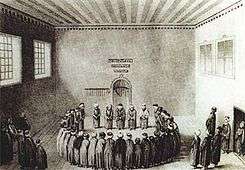Rifaʽi
Rifaʽi (also Rufaʽi, Rifaʽiyya, Rifaʽiya, Arabic, الرفاعية) is an eminent Sufi order (tariqa) founded by Ahmed ar-Rifaʽi and developed in the Lower Iraq marshlands between Wasit and Basra. The Rifa'iyya had its greatest following until the 15th century C.E. when it was overtaken by the Qadiri order. The order is said to wield particular influence in Cairo, Egypt.[1]

| Part of a series on |
| Sunni Islam |
|---|
 |
In terms of Ihsan |
|
|
|
Lists |
|
|
| Part of a series on Islam Sufism |
|---|
|
List of sufis |
|
|
The Rifaʽi order is most commonly found in the Arab Middle East but also in Turkey, the Balkans and South Asia.
History
Records indicate Ahmad al-Rifaʽi inherited his maternal uncle's, Mansur al-Bata'ihi, position of headship to his religious community in 1145-6 C.E. At this time many followed his activities in and around the village of Umm 'Ubayda.[2] In the Lower Iraq marshlands, the Rifaʽi order developed and gained notice throughout the 12th century C.E. due to its extravagant practices. Rifaʽi expanded into Egypt and Syria.
In 1268 C.E., Abu Muhammad ʽAli al-Hariri formed the Syrian branch of the order which became known as the Haririya.[3] The Rifaʽi gained further popularity in Egypt and Turkey. In the 15th century C.E., its popularity waned and the popularity of the Qadiriyya order rose.[4] Subsequently, interest in the Rifaʽi order centered within Arab lands.[5]
The order has a presence in Syria and Egypt and plays a noticeable role in Kosovo and Albania. The Rifaʽi Tariqa blends worship styles or ideas with those of other orders that predominate in the local area. For example, the group established by Kenʽan Rifaʽi in Istanbul that reflects elements of the Mevlevi Order, while more rural Turkish Rifa'is have absorbed significant influence from the Alevi/Bektashi tradition.
The order spread into Anatolia during the 14th and 15th Centuries and ibn Battuta noted Rifaʽi 'tekkes' in central Anatolia. The order however, began to make progress in Turkey during the 17th to 19th centuries when tekkes began to be found in Istanbul. The order spread into the Balkans (especially Bosnia, where they are still present), modern day Albania and Kosovo.
In the United States and Canada tekkes (lodges) are found in Staten Island and Toronto that were under the guidance of the late Shaykh Xhemali Shehu (d.2004) of Prizren, Kosovo. Each of these orders is ultimately Turkish in origin.
The original Rifaʽi order has spawned many branches and derivatives. For example, the Islamic Sufi Order of Qadiri Rifaʽi Tariqa of the Americas has been a legally registered non-profit organization since 1996.[6] This order has students and branches in Australia, Germany, UK, South Africa, and Mauritius. The head of the order, Taner Ansari[7] travels worldwide attending conferences, giving discourses, and has written many books.[8] The order has its center established in Nassau, New York.
Practices
During heightened states of Rifaʽi Ratib, Rifaʽi followers were noted to have eaten live snakes, entered ovens filled with fire and ridden on lions.[9] Followers were also noted to have practiced charming snakes and thrusting iron spikes and glass into their bodies.[10]
It is uncertain whether or not Ahmed ar-Rifaʽi instituted the practices that helped solidify the Rifaʽi order's massive popularity. While some scholars attribute these practices to al-Rifaʽi,[11] other scholars contend he was unaware of these practices and that these were introduced after the Mongol invasion.[12]
Notes
- Bosworth 2010.
- Margoliouth 1997, pp. 38-39.
- Trimingham 1998, p. 39.
- Trimingham 1998, p. 40.
- Bosworth 2010.
- "501c3Lookup - ISLAMIC SUFI ORDER OF QADIRI RIFAʽI TARIQA OF THE AMERICAS". 501c3Lookup.
- "Sufism, Sufis, and Sufi Orders: Sufism's Many Paths". islam.uga.edu. Retrieved 2015-12-27.
- "Ansari Qadiri Rifaʽi Tariqa Sufi Order - Shaykh Taner Ansari Biography".
- Trimingham 1998, p. 38.
- Bosworth 1997.
- Trimingham 1998, p. 37.
- Margoliouth 1997.
Sources
- Bosworth, Clifford Edmund (1997). Rifaʽiyya. The Encyclopaedia of Islam. Brill. ISBN 978-90-04-10422-8.CS1 maint: ref=harv (link)
- Margoliouth, D.S (1997). Bosworth, Clifford Edmund (ed.). al-Rifaʽi b. ʽAli, Abu'l-Abbas. The Encyclopaedia of Islam. Brill. ISBN 978-90-04-10422-8.CS1 maint: ref=harv (link)
- Trimingham, Beirut J. Spencer (19 May 1998). The Sufi Orders in Islam. Oxford University Press, USA. ISBN 978-0-19-802823-9.